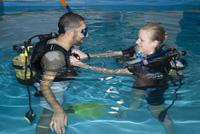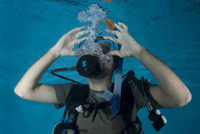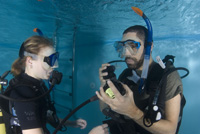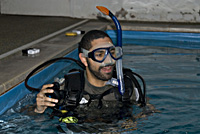- Details
- Written by: David
I’ve always been one to try anything active, but, quite honestly, I can be a bit lazy. I procrastinate, put things off, drag my heels. For me, scuba diving has been like putting up those shelves in the spare room: although I know I’d get a great deal of satisfaction from it, it’s something that I’ve never quite got round to doing (though it would be more fun, obviously).
Now, though, I have an incentive. My girlfriend’s family lives in Indonesia, an archipelago nation that is world-renowned for its spectacular tropical diving. A qualified diver herself, she is planning to visit the relatives soon, and wants me to join her. What better chance to learn the ways of the scuba diver? I could get up to speed in Blighty before entering the azure waters of Southeast Asia. And, at 29 and in pretty good shape, I’m not over the hill yet.
As with many outdoor pursuits, diving has its hazards. Before the lesson, I had to sign disclaimer forms stating that I was responsible for myself, in case the worst happened. But I wasn’t worried: advice from friends, websites and magazines assured me that the risk is absolutely minimal.
However, I am an asthmatic, which ups the risk somewhat. Severe asthmatics are simply barred from diving: an asthma attack while using scuba gear at depth can prove fatal. So, I needed a note from a doctor stating that I was fit to dive. Your GP may not be qualified to give this assurance, so you might need to see a specialist. I decided go to the London Diving Chamber for a medical and, thankfully, got the all-clear.
And so to the dive. On arrival at the London School of Diving, in Chiswick, West London (I work nearby) I was met by the manager Michele, who sat me down and gave me a good talking to. As a complete novice, there were a few essentials that I needed to learn: how water pressure affects the air in your lungs and your ears (more on this later), the ‘buddy’ concept (never, ever dive alone), the basic signals (it’s tricky to chat underwater), and, above all, do not hold your breath – keep breathing naturally.
 Once the pre-dive lesson was over, I changed into my swimshorts and an old T-shirt and entered the fray. Waiting for me was Sarah, one of the school’s top instructors, who would be my guide. I put on the fins (which were initially cumbersome and made me waddle like a drunken Daffy Duck) and the mask, then slipped into the shallow end of the pool.
Once the pre-dive lesson was over, I changed into my swimshorts and an old T-shirt and entered the fray. Waiting for me was Sarah, one of the school’s top instructors, who would be my guide. I put on the fins (which were initially cumbersome and made me waddle like a drunken Daffy Duck) and the mask, then slipped into the shallow end of the pool.
Sarah then introduced me to the buoyancy compensator, or BC – a waistcoat-style garment that looks like a gadget from a James Bond movie. It inflates and deflates, allowing you to be buoyant when at the surface. Attached to this was the all-important air cylinder and regulator (or reg for short – the bit you breathe through).
I spent most of my session learning basic scuba skills. Sarah would demonstrate at the surface, before we knelt on the shallow surface with our heads just below the water line, where I would perform the skill.
I quickly discovered that the trendy beard I’d recently been cultivating had a downside: the hair prevents the mask from forming a watertight seal on the face, letting water seep in which collected below my eyes. This is a common problem, and not just for unshaven oiks like me, which is why another essential skill is emptying your mask underwater. Simply touch the top of the rim of the mask with your fingers, tip your head back and breathe through your nose, expelling the excess water. Although this appears simple, I found it particularly tricky, and let in more water than I’d lost before I got the hang of it.

Other techniques I learned included locating your regulator in the event that it comes out of your mouth, and emptying the reg of any water, either by blowing hard through it or pressing the release button. We also ran through the procedure for breathing from a buddy reg, a spare regulator that allows your companion to breathe from your tank if they ever run low on air – a crucial thing to know, I think you’ll agree.
 Once I’d become more confident, we swam over to the deep end and began playing underwater Frisbee. I initially thought that this was just a pleasant way of passing the time; but I later surmised that it helped me to acclimatise further by focusing my attention on the disc – I therefore stopped thinking about my breathing and did it naturally – and helping me to keep my balance.
Once I’d become more confident, we swam over to the deep end and began playing underwater Frisbee. I initially thought that this was just a pleasant way of passing the time; but I later surmised that it helped me to acclimatise further by focusing my attention on the disc – I therefore stopped thinking about my breathing and did it naturally – and helping me to keep my balance.
The major problem I had was equalising the air pressure in my ears. When you dive down a few metres, you can feel the change in pressure – it’s akin to being in an aircraft as it ascends or descends. It’s normally easy to rectify this, but underwater it’s a different story, so I ended up with a bit of a headache. I also found it tricky to orientate myself, and often ended up swimming off at wild angles, but Sarah helped me to remain straight and horizontal. Even though I was only in a small, chlorine-filled pool, I felt a wonderful freedom from the constraints that prevent us from being more aquatic. I didn’t have to worry about going up for air, and the absence of sound (apart from me breathing through the reg) made it a serene experience. I was amazed by how natural it felt.
While a certain level of physical fitness is needed to dive, I was surprised at how little I exerted myself underwater. But I was absolutely shattered once I arrived back home and had to have an early night, after almost passing out in my pasta dinner. Perhaps I’m not as fit as I reckoned. Quite simply, I loved my first taste of diving. I’ll definitely take the open water course.
Get Started...
There are dive clubs and schools all around the country. Visit bsac.com/comediving/trydives.html for information on try-dives with the British Sub Aqua Club (BSAC).
www.Padi.com/padi/en/sd/wherecanidive.aspx has details of your nearest PADI centre or school.
Marc did a try-dive at the London School of Diving.




